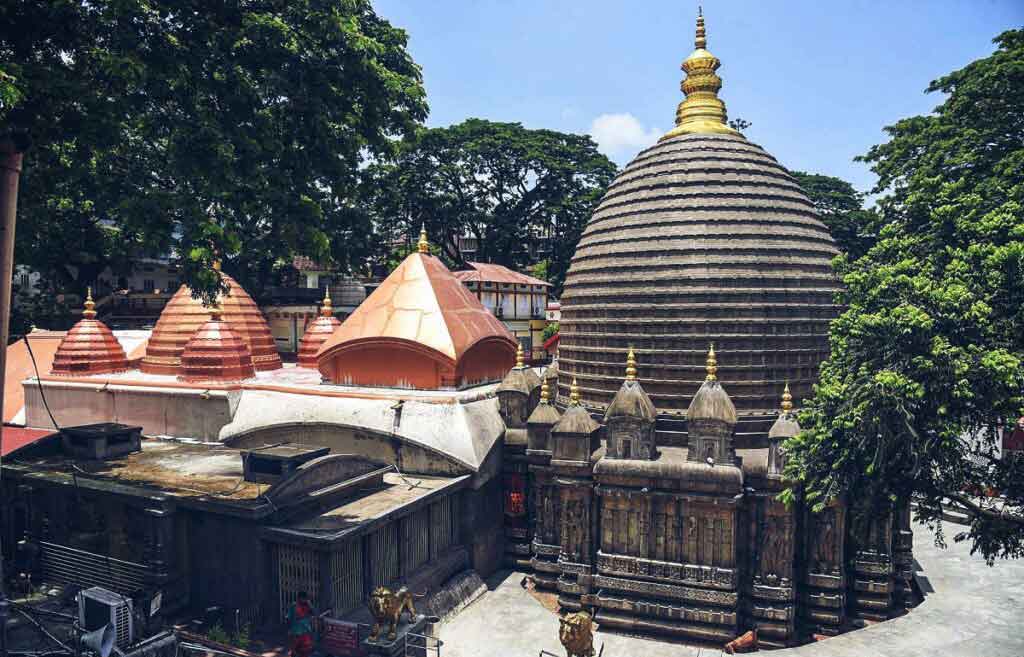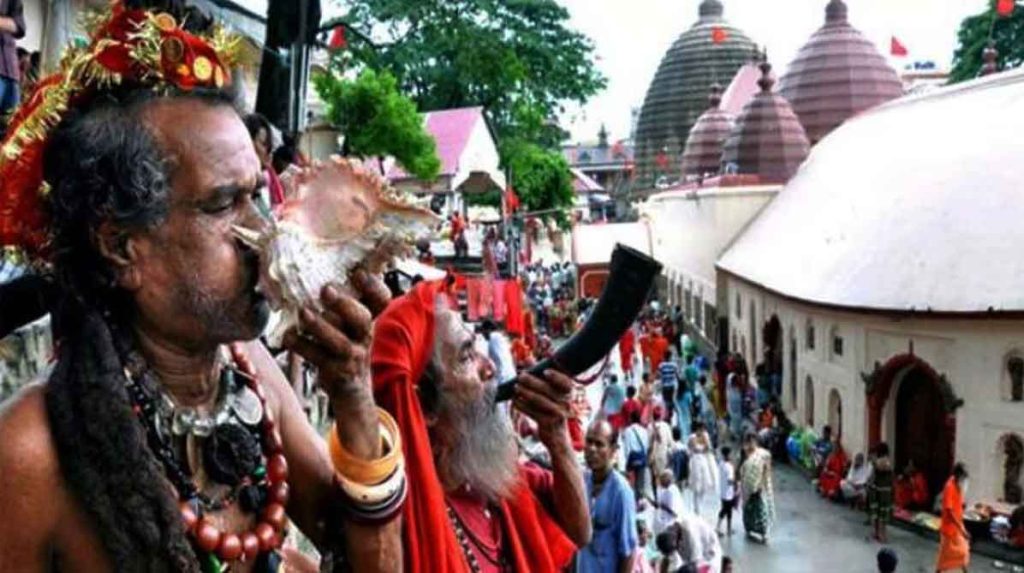
Kamakhya Temple: A Journey of Faith and Healing
Table of Contents
Kamakhya Temple: Introduction
The Kamakhya Temple is a place of profound spiritual significance located on the Nilachala Hills of India in the heart of Assam. This ancient temple is not only an architectural marvel but also a symbol of feminine divinity. With a rich history spanning centuries, Kamakhya Temple holds numerous secrets, mysteries and traditions that continue to enthrall pilgrims and tourists alike.

The Kamakhya Temple: A Brief Overview
The Kamakhya Temple, also known as Kamrup-Kamakhya, is dedicated to the Goddess Kamakhya, an incarnation of the Mother Goddess, revered for her unique power. This temple is one of the 51 Shakti Peethas, sacred sites where body parts of the Goddess Sati, wife of Lord Shiva, are believed to have fallen.
Historical Significance
The Kamakhya Temple has a long history that begins in past times. It has witnessed various rulers, including the Koch, Ahom, and Mughal dynasties. The temple’s architecture and the legends surrounding it are a testament to the rich historical tapestry of Assam.
Spiritual Significance
For devotees, the Kamakhya Temple is extremely spiritually significant. It is a place where the Goddess’s unique form, the Yoni, is worshipped with great devotion. This practice symbolizes the divine power of creation.
The Enigmatic Kamakhya Temple: Unveiling the Mysteries
Hidden Chambers
Rumors of hidden rooms and secret passages within the temple continue, further fueling the intrigue surrounding this ancient temple.
Kamakhya as a Living Goddess
The belief that Kamakhya is a living goddess adds to the mystery. Devotees consider her to have moods and emotions.
Architectural Marvel
The architecture of the temple is a mixture of Assamese and Bengali styles. It features beehive-shaped flames and intricate sculpture. The Nilachala hill location offers a breathtaking view of the Brahmaputra river and surrounding landscape.

Unique Practices and Rituals
The unique customs and rituals of this temple include the Ambubachi festival, when the goddess is believed to have her menstrual cycle and the temple remains closed for three days. Kamakhya prasad (blessed food) and the famous sindoor (sindoor) are considered very auspicious.
The Annual Ambubachi Mela
The annual Ambubachi Mela is an extraordinary event that attracts millions of devotees and tourists from all over the world. This holy festival is held in the holy premises of the Kamakhya Temple in Guwahati, Assam, India.

The Ambubachi Mela has its roots in ancient Indian mythology. It is said that this festival celebrates the divine menstruation of Goddess Kamakhya. According to legend, when Lord Shiva’s wife Sati committed suicide in her father’s yajna (sacrificial fire), Shiva went into a state of deep mourning. To save the world from his suffering, Lord Vishnu cut Sati’s body into 51 pieces with the help of his Sudarshan Chakra. Every piece of her body fell to earth, and these are now considered Shakti Peeths, places of immense spiritual power. It is believed that the reproductive organs of Sati collapsed at the site where the Kamakhya temple stands today.
The Ambubachi Mela celebrates the annual menstruation of Goddess Kamakhya, an event that is observed with great reverence. The temple is closed for three days during this period as it is believed that the goddess is going through her menstrual cycle.
Rituals and Observances
Ambubachi Mela is a time of profound spiritual significance. Devotees come to the Kamakhya temple to witness and be a part of the rituals associated with the festival. Some of the main rituals include:
1. Nilachal Parva
This ceremony involves preparations for the goddess’s annual menstruation. During this time, the temple priests perform various secret tantric rituals.
2. Ambubachi Days
Devotees are not allowed to perform any rituals or offerings during the three days the temple is closed. Instead, they engage in prayer, meditation and fasting to seek the blessings of the goddess.
3. Reopening Ceremony
The temple reopened after three days amidst much fanfare and celebration. It is believed that the goddess purifies herself at this time.
4. Prasad Distribution
A significant part of the festival is the distribution of ‘angadhaka’ or ‘prasad’, which includes a small piece of cloth believed to absorb the menstrual blood of the goddess.
Significance
The Ambubachi Mela is not just a religious gathering, it is a cultural celebration. This has immense significance as stated below:
1. Spiritual Purification
Devotees believe that a visit to the Kamakhya temple during the Ambubachi Mela cleanses all their sins and fulfills their wishes due to the belief in the extraordinary power of the goddess.
2. Cultural Diversity
The festival provides a platform for cultural exchange, with different tribal communities and artists showcasing their traditions, dances, and music. This blend of cultures adds a unique charm to the event.
3. Tourism Boost
The Ambubachi Mela attracts millions of tourists, contributes significantly to the local economy and promotes Assam as a major tourist destination.
4. Social Harmony
This annual gathering fosters unity and harmony among people from different backgrounds, emphasizing the oneness of humanity.
Ambubachi Mela Today
In recent years, the New Year’s Eve has seen a surge in popularity and participation. Modern facilities, better connectivity, and increased awareness have contributed to its growth. The Government of Assam in collaboration with various organizations has been working to improve the infrastructure and facilities for the pilgrims and tourists who flock to the festival.
The annual Ambubachi Mela at the Kamakhya Temple is a convergence of faith, tradition and spirituality. It is an event that seamlessly blends the spiritual and cultural aspects of India and attracts people from all over the world. The unique events and deep significance of this festival make it a remarkable one.

Kamakhya Temple’s Role in Assamese Culture
The Kamakhya Temple plays an important role in Assamese culture. It is not only a religious place, but also a symbol of unity and cultural identity for the people of Assam. The temple has influenced Assamese art, literature, folklore, etc.
Preservation Efforts
Preservation of the heritage of the Kamakhya Temple is of utmost importance. Various organizations and government agencies work diligently to preserve this architectural and cultural wonder.
How to Reach Kamakhya Temple
For those planning to visit, the temple is easily accessible by road, rail, and air. The nearest railway station is Guwahati, and the Lokpriya Gopinath Bordoloi International Airport is the closest airport.
Best Time to Visit Kamakhya Temple
The best time to visit Kamakhya Temple is during the monsoon season (June to September) when the lush green surroundings add to its mystical charm.
Personal Experiences and Stories
Visitors often share their personal experiences and stories of spiritual awakening and transformation after visiting the Kamakhya Temple. It continues to touch the lives of people in profound ways.
Conclusion
In conclusion, Kamakhya Temple stands not only as a religious place, but also as an icon of the cultural identity of Assam. Its history, spiritual significance, unique approach, and architectural beauty make it a must-visit destination for anyone exploring Assam. A place where tradition and spirituality come together, it leaves a lasting impression on all who are fortunate enough to experience it.
FAQs
Is the Kamakhya Temple open to all visitors throughout the year?
Yes, the temple is open to visitors throughout the year, except during the annual Ambubachi festival when it remains closed for three days.
Are there any specific dress code requirements for visiting the temple?
While there isn’t a strict dress code, it is advisable to dress modestly and respectfully when visiting the temple.
What is the significance of the sindoor (vermilion) from Kamakhya Temple?
The sindoor is considered highly auspicious and is believed to have the blessings of the Goddess. Devotees often use it for worship and as a symbol of her grace.
Can non-Hindus visit the Kamakhya Temple?
Yes, visitors of all faiths are welcome to the temple. It is a place of spiritual and cultural significance, welcoming visitors from diverse backgrounds.
What are the nearby attractions that one can explore when visiting Kamakhya Temple?
Some of the nearby attractions include Umananda Island, Assam State Museum, and the Peacock Island Wildlife Sanctuary, Kaziranga Golf Resort , Kaziranga National Park etc.
Can you provide best travel agency visit to kamakhya temple?
Yes, Assam Tours & Travels is one of the best.

